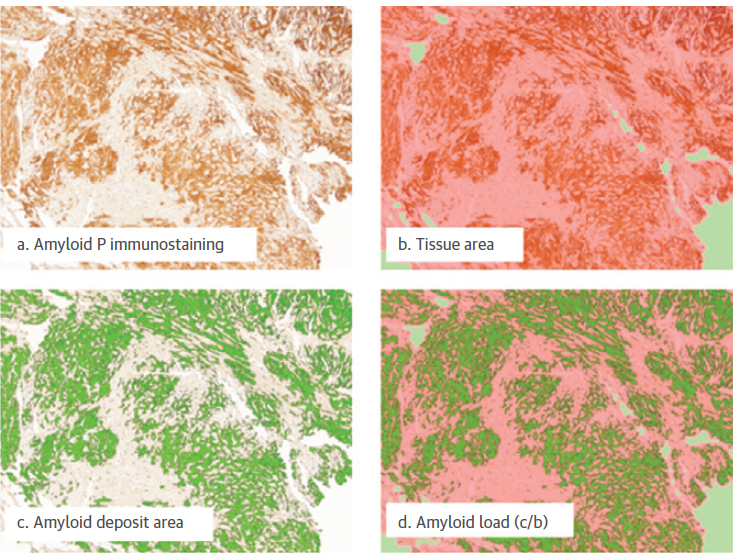Inside Labs
Inside Labs
Imaging-Based Biomarker Helps Determine the Risk of Cardiac Amyloidosis
Update 22.12.2022
Researchers examine association between protein misfolding and abnormal heart function
Light chain amyloidosis can damage
multiple organs, including the heart. This
can manifest as decreased left ventricular global longitudinal strain (LV GLS),
a form of cardiac malfunction. In a new study, Samsung Medical Center researchers
found a modest-yet-significant association between cardiac amyloid loads and LV
GLS. In doing so, they established that LV GLS may be a useful biomarker to refine
clinical risk stratification in cardiac amyloidosis.

Researchers from Samsung Medical Center, South
Korea, examined and established a distinct correlation between light chain amyloidosis
and left ventricular global longitudinal strain, a type of cardiac anomaly, suggesting
that the latter may bestow additive prognostic value to the present risk
stratification system of amyloidosis. The image shows amyloids in tissue samples
from the heart of a patient with left ventricular global longitudinal strain.
Image courtesy: Eun-Seok Jeon, Samsung Medical
Center
Proteins
are necessary for our survival. However, the proper functioning of important
proteins like enzymes and antibodies hinges on their accuracy of their
structures. Misfolded proteins are highly problematic and can give rise to several
serious diseases—Parkinson’s disease, Alzheimer’s disease, and Huntington’s
disease, to name a few. These abnormal proteins can deposit in any organ in the
form of aggregates known as “amyloid fibrils,” in process called amyloidosis.
In
a recent study, biomedical researchers at Samsung Medical Center, South Korea,
recently examined the likely association between cardiac amyloid loads and decreased left ventricular global longitudinal strain (LV GLS). Their findings were recently published in JACC:
Cardiovascular Imaging.
The study was supported by a fund (code: 2019ER690200) by Research of Korea
Centers for Disease Control and Prevention.
Says lead investigator Dr. Darae Kim, “Cardiac
amyloidosis is rare in occurrence, but it is also an overlooked cause of heart
failure. Echocardiography (or 2D-echo as is usually referred to) is typically
the first imaging technique used in the diagnosis of cardiac amyloidosis, and
it also provides reliable prognostic information. Previous studies indicate that
decreased LV GLS is associated with poor prognosis in cardiac amyloidosis.
However, there are no detailed studies examining the association between
reduced LV GLS and amyloid protein aggregates in the heart.”[A1] [A2] [A3]
For
the study, the team recruited 77 patients with cardiac disease. All patients
underwent endomyocardial biopsy. In addition, 2D conventional transthoracic echocardiography
was performed to evaluate the functioning of the heart.
The
analyses included measurement of N-terminal pro-B-type natriuretic peptide
(NT-proBNP) and troponin T at the time of diagnosis. High levels of NT-proBNP indicate heart failure. Similarly, the
presence of troponin T in the blood indicates damage to the cardiac muscles.
Next,
the team immunohistochemically stained the extracted biopsy sample to estimate
the amyloid load in the tissue. Meanwhile, patient mortality was documented and
patients showing complete response, good partial response, or partial response to
treatment were classified as “responders.” From the group of 77 patients, 40
patients were classified as responders.
The results were encouraging: LV GLS showed a modest
but significant correlation with the amyloid protein aggregates detected in the
heart tissue and the logarithm of the amount of NT-proBNP detected in the blood
stream. Despite the modest association, the researchers considered LV GLS to
have demonstrated significant additive prognostic value. Thus, the team
successfully identified a new imaging-based biomarker for refining risk
stratification of cardiac amyloidosis resulting not only from amyloid protein
aggregates, but also from cardiotoxicity and fibrosis.
“Cardiac involvement is a critical prognostic factor
in patients with light chain amyloidosis. If novel treatment options are made available for patients with light-chain
amyloidosis, LV GLS could be used as an
imaging biomarker to help better distinguish between patients with varying
degrees of risk and also for monitoring prognosis ,”[A4] [A5] notes Dr. Kim.
Reference
|
Authors
|
Darae Kim, Jin-Oh Choi, Kihyun Kim, Seok Jin Kim, Jung-Sun Kim,
Eun-Seok Jeon |
|
Title of
original paper |
Association of Left Ventricular Global Longitudinal Strain With
Cardiac Amyloid Load in Light Chain Amyloidosis |
|
Journal |
JACC: Cardiovascular Imaging |
|
DOI |
10.1016/j.jcmg.2020.12.009 |
|
Affiliations |
Division of Cardiology, Department of Medicine, Heart Vascular Stroke
Institute, |
About
National Institute of Health in
The Korea
National Institute of Health (KNIH), one of the major operating components of
the Ministry of Health and Welfare, leads the nation’s medical research. Over
the past seven decades, the KNIH has made unwavering efforts to enhance the
public’s health and innovate biomedical research. The KNIH seeks to eradicate
diseases and make people healthier. The KNIH establishes a scientific basis and
evidence underlying health policy as well as provides national research
infrastructures. We also promote public health research. To this end, we make
efforts to enrich a health research environment by granting funds to research
projects and keeping our resources, data, and facilities more open and
accessible to researchers.
Website:
http://www.nih.go.kr/NIH_ENG/
About Dr. Darae Kim
Dr. Darae Kim is an Assistant Professor
of Cardiology at the

